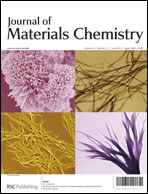PLL/pDNA/P(His-co-DMAEL) ternary complexes: assembly, stability and gene delivery
Abstract
Poly(L-lysine) (PLL) is a kind of biocompatible and biodegradable polycation and can effectively condense plasmid DNA (pDNA) to form nano-scaled complexes. However, the ultra-low gene transfection efficiency limits its wide application in gene delivery. Here, an uncharged functional polymer P(His-co-DMAEL) is synthesized by reversible addition fragmentation transfer (RAFT) polymerization and characterized with 1H NMR spectrum and size exclusion chromatography (SEC). P(His-co-DMAEL) is assembled with pDNA and PLL to form PLL/pDNA/P(His-co-DMAEL) ternary complexes. Gel shift assays and dynamic light scattering (DLS) tests indicate that the stability of PLL/pDNA/P(His-co-DMAEL) ternary complexes under various conditions is much better than that of PLL/pDNA binary complexes. In vitro transfection shows that the gene transfection efficiency of PLL/pDNA/P(His-co-DMAEL) ternary complexes is much higher than that of PLL/pDNA counterparts and the “gold standard” of gene transfection, poly(ethyleneimine)/pDNA (PEI/pDNA) complexes, especially under serum conditions. Cytotoxicity assays show that PLL/pDNA/P(His-co-DMAEL) ternary complexes have no cytotoxicity. The ternary complexes have advanced the application of PLL as a gene carrier and will have enlightening significance for the development of novel gene and drug delivery carriers.


 Please wait while we load your content...
Please wait while we load your content...